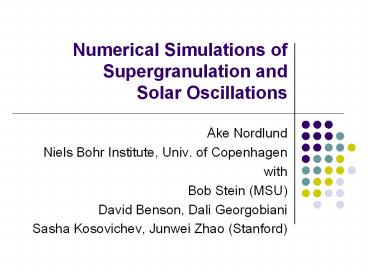Numerical Simulations of Supergranulation and Solar Oscillations - PowerPoint PPT Presentation
Title:
Numerical Simulations of Supergranulation and Solar Oscillations
Description:
fast about 5 CPU-microseconds / mesh-update. includes 4-bin ... vert. velocity, surface intensity. Velocity, as seen by VAPOR (top perspective) Sunspot, ... – PowerPoint PPT presentation
Number of Views:20
Avg rating:3.0/5.0
Title: Numerical Simulations of Supergranulation and Solar Oscillations
1
Numerical Simulations of Supergranulation and
Solar Oscillations
- Åke Nordlund
- Niels Bohr Institute, Univ. of Copenhagen
- with
- Bob Stein (MSU)
- David Benson, Dali Georgobiani
- Sasha Kosovichev, Junwei Zhao (Stanford)
2
Experiment settings Code
- Staggered mesh code
- conservative, with radiative transfer
- fast about 5 CPU-microseconds / mesh-update
- includes 4-bin radiative transfer
- massively parallel
- OpenMP up to about 250 CPUs
- MPI up to thousands of CPUs (just developed)
- Hybrid MPI/OMP for clusters with shared mem.
nodes - e.g. DCSC/KU 118 nodes x dual-CPUs x dual core
AMD 472 cores (corresponds to 90 million
zone-updates / sec)
3
Stagger CodeScaling on Columbia (Altix)
- With OpenMP
- With MPI
Size N-cpu µsec/pnt
125x500x125 1 5.9
250x500x250 64 8.6
500x500x500 64 7.8
500x500x500 125 9.3
500x500x500 250 11.9
Size N-cpu µsec/pnt
250x500x250 1 4.3
250x500x250 50 4.7
500x500x500 50 5.3
500x500x500 100 6.1
500x500x500 250 6.7
4
Supergranulation Simulation48 Mm wide x 20 Mm
deep
- 63 hours (1.3 turnover time)
- f-plane rotation (surface shear layer)
- No magnetic field (yet)
- Low resolution
- 100 km horizontal,
- 12-70 km vertical
5
Mean Atmosphere Ionization of Hydrogen and Helium
6
What can we learn?
- Use the model and data as a test bed
- SOHO/MDI synthetic data
- what does SOHO/MDI actually measure, and how
well? - Local helioseismology
- what do the various methods measure, and how
well? - Nature of the flow field
- What is supergranulation?
- How does it fit in with larger smaller scales?
7
Data sets available onStanford Helioseismology
Archive
8
Upflows at surface come from small area at bottom
(left)Downflows at surface converge to
supergranule boundaries (right)
9
Animation
10
Time evolution at various depths
11
Velocity at the same depths
12
The solar velocity spectrum
- Power spectra are often plotted log-log, which
means the power per unit x-axis is really k
P(k), rather than just P(k)!
13
Solar velocity spectrum
Velocity spectrum v(k) (k P(k))1/2
14
Rotation subtracted solar Doppler image
15
Ni 6768 response function
16
k-w Diagram
simulation
MDI
17
Sub-sonic filtering
7 km/s
18
P-mode power (red), convective power (black)
time average (blue)
Note that it matters very much how one computes
power spectra
Hi-res MDI
19
Velocity spectrumonly distinct scale is
granulation
- - - - convection
Vhoriz (sim)
Vz(sim)
. oscillations
V MDI
20
A continuous solar velocity spectrum!
- Supergranulation may stand out a little
- But the flow is nearly scale-invariant
- amplitudes scale inversely with size
- lifetimes scale with the square of the size
21
A Nearly Scale Free Spectrum!Doppler Image of
the Sun (SOHO/MDI)
22
Solar horizontal velocity (observed)Scales
differ by factor 2 which is which?
23
Solar horizontal velocity (model)Scales differ
by factor 2 which is which?
24 Mm
12 Mm
6 Mm
3 Mm
24
Solar velocity spectrum
25
Time-Distance Diagram
26
f-mode Travel Times vs Simulated Flow Fields
(divergence)
Right side image shows the f-mode outgoing and
ingoing travel time differences, and the left
side image shows the divergence computed from
simulation. (From Junwei Zhao)
27
f-mode Travel Times vs Simulated Flow Fields
(Horizontal)
Right side image shows the f-mode north-going and
south-going travel time differences, and the left
side image shows the Vn-s averaged from
simulation. (From Junwei Zhao Aaron Birch)
28
Local Correlation Tracking
29
Sunspots
30
Sunspot, initial time evolution
31
Sunspot, time evolution (rep.)
32
Temperature, hor. vert. magn. field,hor.
vert. velocity, surface intensity
33
Velocity, as seen by VAPOR(top perspective)
34
Sunspot,log magnetic pressure
35
Sunspot, field lines with density iso-surface
(solar surface)
36
Field line detail
37
Key result A continuous solar velocity spectrum
- Supergranulation may stand out a little
- But the flow is nearly scale-invariant
- amplitudes scale inversely with size
- lifetimes scale with the square of the size
38
Data sets available onStanford Helioseismology
Archive
39
ExperimentsForthcoming
- AR magnetic fields
- add B from MDI magnetogram (as in Gudiksen
Nordlund) - Quiet Sun magnetic fields
- advect initially horizontal field from the bottom
b.c. - Rise of magnetic flux tube
- Insert flux tube near bottom, study emergence
through surface - Coronal chromospheric heating
- similar to Gudiksen Nordlund, but real driving
40
The End































